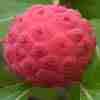|
|
|
 |
CORNUS kousa
'Akebana' A pink bracted selection originating in Japan. As a very minor point of interest, this one seems to naturally form a more symmetrical plant than the other pinks. |
|
|
|
| CORNUS kousa
'All Summer' This is a particularly splendid form with a tidy and upright habit, with rich green foliage. Long lasting bracts as the name implies! See it in our Quarry Garden and Woodland Walk. |
|
|
|
|
| CORNUS kousa
'Akatsuki' This is a variegated sport from 'Satomi' which originated in Japan. The leaves are green with broad, irregular white margins. The deep pink bracts contrast well with the variegated foliage. Unfortunately, it is a comparatively weak plant which needs close to ideal conditions in order to thrive. |
|
|
|
|
| CORNUS kousa
'Autumn Rose' This is a delightful American selection, whose bracts open light green before maturing to soft white. However, it is the foliage which makes this one unique - the yellow to lime green spring growth gives way to green wavy leaves in summer which develop myriad shades of pink to red autumn colours. It seems to lack the vigour of most kousa cultivars, which makes it suitable for small gardens although it does need a kinder site. See it in the gardens here. |
|
|
|
|
 |
CORNUS kousa
'Big Apple' Large spreading tree with heavy textured dark green leaves and extremely large fruit. |
|
|
|
| CORNUS kousa
'Blue Shadow' Another fantastic American selection which seems to be extremely robust. The leaves are larger and more substantial than most, being a rich bluish green in colour. Reddish autumn colour. Long-lasting white bracts and fruit. Particularly heat tolerant. |
|
|
|
|
| CORNUS kousa
var. chinensis 'Bodnant' The young stems are distinctly purple and the large creamy white bracts are freely produced. It also sets fruit freely. This one seems reluctant to make a symmetrical tree shape, so may be best grown in a more informal manner, effectively as a large shrub |
|
|
|
|
| CORNUS kousa
'Bump' A dwarf form of bushy habit. More shrubby in habit, this won't naturally form a tree. Excellent exfoliating bark is an unexpected bonus. |
|
|
|
|
| CORNUS kousa
'Capuccino' The larger the collection one has, the harder it is to find something "different" and I am determined that we will not add to it just for the sake of collecting another name! Nor am I interested in growing things that may be "different" but for all the wrong reasons, making them of little ornamental merit. Of course sometimes it is necessary to grow something for a while to be able to see for yourself whether it is worthy of a place. Therefore I am particularly thrilled with this more recent selection and addition to our collection, which is without a doubt both "different" and worthy of a place in any garden. It is distinguished by rather lovely foliage, warmly flushed with coppery bronze tones all season. The prolific bracts are the typical shape, whilst the creamy colouring shows up beautifully against the darker foliage. This one also readily develops an elegant structure, making it a brilliant all-rounder. |
|